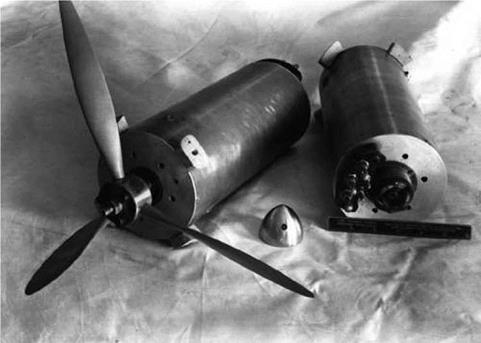Propeller Effects on Stability and Control
A remarkable paper by a Cal Tech professor was a source for years afterwards of propeller power effects on static longitudinal and directional stability (Millikan, 1940). Millikan’s paper was based primarily on test results from Cal Tech’s Guggenheim Aeronautical Laboratories’ (GALCIT) low-speed wind tunnel. The tunnel staff and the companies who tested new aircraft models there had the foresight to develop both the hardware and techniques needed to run tests that simulated power-on flight conditions. The primary hardware need was for compact, powerful electric motors that could be mounted inside model fuselages(Figure 4.1). Electric motorsof thistype with larger diametersand lower power had been designed and installed in British N. PL. wind tunnel models much earlier (Relf, 1922).
Testing techniques required that model thrust be adjusted to predicted full-scale conditions. This ensured that the slipstream velocities behind the model propellers were in the correct proportions to free-stream velocities. Propeller effects on stability and control arise from two other factors aside from the slipstreams washing over wings, tail surfaces, and fuselages. These are the simple direct-thrust moments in pitch and yaw and the forces and moments acting on the propellers themselves. The following sections trace the development of our understanding of these effects.
|
Figure 4.1 A typical compact electric induction motor developed in the late 1930s for powered wind – tunnel models. These motors developed 5 to 12 horsepower at 18,000 RPM. (From Millikan, Jour of the Aeronautical Sciences, Jan. 1940) |












